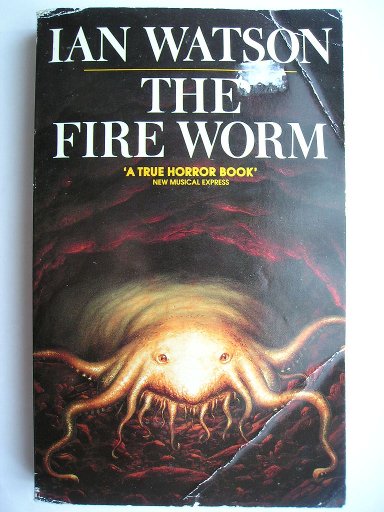
The novel “The Fire Worm” by Ian Watson was published for the first time in 1988.
John Cunningham is a psychiatrist who has a kind of double life in which his alter-ego Jack Cannon is a horror writer. To maintain his medical reputation, he reveals no information about his true identity, not even to his publisher. However, his second identity is to him like a second personality.
In his work as a psychiatrist, John Cunningham uses a hypnotic regression therapy to help his patients understand the causes of their problems and overcome them. For him it’s only a tool but he believes that his patients’ past lives they tell him about under hypnosis are just projections of their real life. But when Tony starts telling him stories dating centuries back he starts thinking that his stories may be true and behind the legend of the Lambton Worm there can be a terrifying reality.
In 1986, Ian Watson published a short story titled “Jingling Geordie’s Hole” in the magazine “Interzone” that tells a story connected to English folklore. Only later, the author decided to greatly expand the story around it and wrote the novel “The Fire Worm”.
Ian Watson is an author who has always mixed various genres so it’s practically impossible to label him. “The Fire Worm” brings together elements of horror, even with Lovecraftian tones, in a story that includes reincarnation and regressive hypnosis and can therefore be considered science fiction or fantasy. In addition, there’s the topic of sexuality, which in the novel is treated from the point of view of the second half of the ’80s, when the problem of AIDS exploded.
The story centers around psychiatrist John Cunningham from both his personal point of view and concerning his treatments based on regressive hypnosis. The development of the characters is different from usual because almost all of them are somehow fragmented: Cunningham because he has an alter-ego who is a horror writer and his patients because they have past lives.
For John Cunningham, Jack Cannon isn’t simply a pen name he uses to keep his identity hidden but a real alter-ego with his own personality. In the course of the novel, John and Jack talk to each other and from the use of first-person narrative, opposed to the third-person narrative, the reader can understand the character and the relationship he has with himself.
The part of the novel concerning hypnotic regression is even more complex, mainly that of Tony. Various stories tell episodes of different past lives reaching the Middle Ages. Going back in time, John Cunningham discovers a series of links with the legend of the Lambton Worm that convince him that there’s something real in it.
In my opinion, “The Fire Worm” is only partly successful. The novel is from 1988, when the standards allowed to write novels of a certain length even in the British market. However, this novel is relatively short, with my paperback being 240 pages long. For a story that brings together elements of various genres in a plot fragmented into parts set in different centuries they’re not enough.
Ian Watson manages to develop well protagonist and his personality split between John Cunningham and Jack Cannon, and in general the characters are a strong point of the novel. The final impression, however, is that there are a number of stories sometimes evenly connected rather than a single story about the Lambton Worm.
Ian Watson is an author who often wrote stories in which he put together elements apparently unconnected with great imagination. In “The Fire Worm” he was inspired by English folklore, certainly not an original basis, to create a very special story. This choice is appreciable but also difficult, in fact not always Watson manages to make his story work completely.
Overall, I find that “The Fire Worm” is a novel in some ways very intriguing because but it’s difficult form me to recommend it because it’s peculiar and has its flaws. It’s probably best suited to the readers who already know Ian Watson and know can appreciate his style.


Permalink